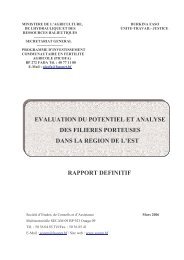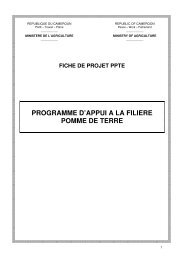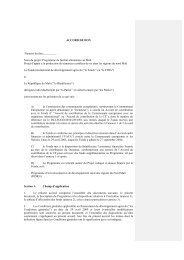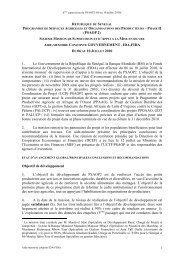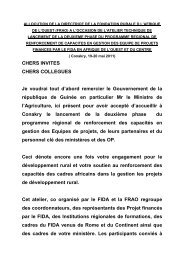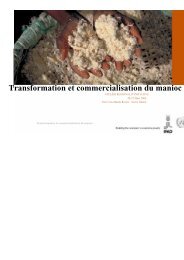Scaling Up the Fight Against Rural Poverty - FIDAfrique
Scaling Up the Fight Against Rural Poverty - FIDAfrique
Scaling Up the Fight Against Rural Poverty - FIDAfrique
Create successful ePaper yourself
Turn your PDF publications into a flip-book with our unique Google optimized e-Paper software.
In comparison to o<strong>the</strong>r international financial institutions (such as <strong>the</strong> World Bank, EIB or <strong>the</strong> EBRD),<br />
IFAD projects are only broadly designed prior to approval. Much of detailed design work is done<br />
during implementation through annual work programs. This loose loan design and <strong>the</strong> important role<br />
that <strong>the</strong> annual work programs play have great significance for scaling up. As <strong>the</strong> design phase of an<br />
IFAD project only broadly defines a project, <strong>the</strong> pathway for scaling up will also be primarily designed<br />
during implementation under <strong>the</strong> guidance of <strong>the</strong> operating manual. Many adjustments will be made<br />
during implementation. Therefore <strong>the</strong> conceptual framework for scaling up needs to be embedded into<br />
<strong>the</strong> IFAD culture, and sensitivity for scaling up requirements need to be raised within IFAD Country<br />
Management Teams and at stakeholder workshops. And very importantly, robust M&E needs to be<br />
built into projects to signal whe<strong>the</strong>r objectives are being achieved and to collect <strong>the</strong> information<br />
needed to inform an effective scaling up process.<br />
2. Project implementation and supervision<br />
Since 2007, IFAD undertakes direct supervision under <strong>the</strong> guidelines provided in <strong>the</strong> policy paper on<br />
“Supervision and Implementation Support”. Prior to that, IFAD projects were supervised through<br />
delegated institutions, such as <strong>the</strong> World Bank or <strong>the</strong> United Nations (UNOPS). Direct supervision<br />
provides <strong>the</strong> opportunity to work on <strong>the</strong> pathway of scaling up. <strong>Scaling</strong> up can now be addressed from<br />
<strong>the</strong> design, <strong>the</strong> implementation and completion phase by <strong>the</strong> same country program team.<br />
IFAD has issued very detailed operational guidelines on how to conduct supervision. These guidelines<br />
provide some guidance on how to address innovation and knowledge management but not on scaling<br />
up. Looking ahead, <strong>the</strong>se guidelines should be revised to reflect an explicit focus on scaling up.<br />
3. Project completion<br />
Activities associated with project completion are laid out in <strong>the</strong> Guidelines for Project Completion,<br />
including <strong>the</strong> preparation of a Project Completion Report (PCR). The underlying assumption of <strong>the</strong>se<br />
guidelines is that <strong>the</strong> project is a distinct set of activities, undertaken during a defined, limited period<br />
of time, which by its nature comes to completion. The guidelines lay out <strong>the</strong> assessments that need to<br />
be carried out to “complete” <strong>the</strong> project cycle. Questions in <strong>the</strong> guidelines, whe<strong>the</strong>r project activities<br />
are sustainable and how <strong>the</strong>y can be made sustainable are addressed but do not play a central role. The<br />
Guidelines mention <strong>the</strong> need for an “exit strategy” in laying out <strong>the</strong> agreements that need to be reached<br />
on post-project responsibilities to assure sustainability. They also refer in passing to replicability and<br />
scaling up, but not as core elements of <strong>the</strong> completion process<br />
While project completion guidelines and project completion reports should explicitly address scaling<br />
up, <strong>the</strong> completion process in a project cycle should not be <strong>the</strong> only, and not even t<strong>the</strong> most important<br />
stage in <strong>the</strong> project cycle at which to address scaling up issues. It is in <strong>the</strong> design and implementation<br />
phases during which scaling up pathways and post-project trajectories need to be laid out and pursued.<br />
If this is not done during <strong>the</strong>se earlier phases, <strong>the</strong> completion phase on its own will not make a<br />
substantive contribution.<br />
32





